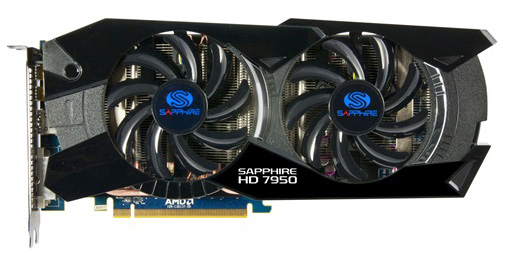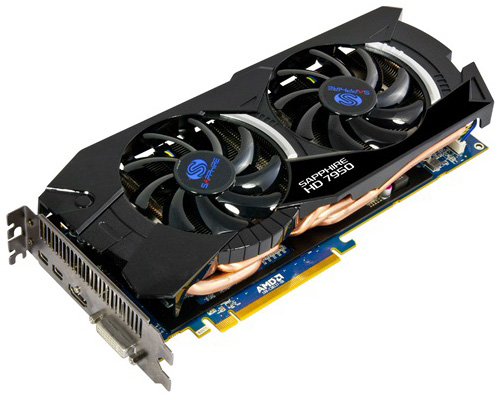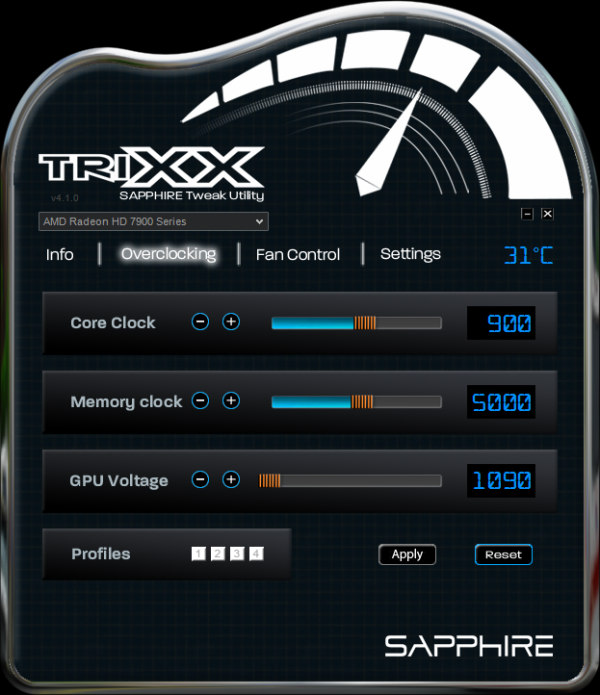AMD Radeon HD 7950 Review Feat. Sapphire & XFX: Sewing Up The High-End Market
by Ryan Smith on January 31, 2012 9:02 AM ESTMeet the Sapphire HD 7950 Overclock Edition
Since our reference 7950s are built on the 7970 PCB and cooler, we’re going to jump right into our vendor cards starting with the Sapphire HD 7950 Overclock Edition.
As with all of the 7950 cards launching today, Sapphire’s HD 7950 Overclock Edition uses the AMD 7950 PCB. This is a slightly shorter PCB measuring 10.25” long, saving .25” over the 7970 PCB by eliminating a few components that the lower board power of the 7950 makes unnecessary. The PCB is otherwise very similar to the 7970 PCB, utilizing 12 GDDR5 memory chips organized around the Tahiti GPU, while at the top you’ll find the 2 CrossFire connectors, a pair of 6pin PCIe power sockets, and the BIOS selection switch. The latter will be of particular interest to unlockers, as the switch should make it possible to safely attempt to unlock the 7950 into a 7970.

Moving on, as this is a semi-custom card the real differentiation is in the factory overclock and the cooler. On the performance side of things Sapphire will be shipping the 7950 Overclock Edition at 900MHz core and 5GHz memory, representing a 100MHz (12.5%) core overclock and no change on the memory clock.
Meanwhile for the cooler Sapphire is using what they’re calling the Dual-X cooler. The Dual-X is yet another double-wide dual-fan open air cooler, with 2 fans providing copious airflow over an aluminum heatsink running virtually the entire length of the card. Sapphire’s fan cutouts are just a bit bigger than most other dual-fan coolers and placed a bit higher, and as a result the Dual-X cooler is a bit taller than the PCB by about 15mm at its highest point. Meanwhile the cooler is also a fair bit longer than the PCB, putting the total card length at 11”.
Moving below the fans and the heatsink we’ll find the heatpipe assembly, which is responsible for carrying heat from the GPU to the heatsink. The Dual-X uses 5 copper heatpipes of varying radius that run from one end of the heatsink to the other. The 5 heatpipes converge at the base of the assembly, where a copper baseplate provides contact with the GPU. Meanwhile cooling for the VRM MOSFETs and RAM is provided by a black aluminum plate, which is placed over those components with heat transfer provided by the use of thermal pads. There is no connection between the plate and the heatsink, so the only heat dissipation from the plate is provided by whatever airflow from the fans reaches the plate.

At the front of the card we’ll find the display ports, which as this is an AMD PCB the card utilizes the standard AMD 7000 series port configuration of 1 DL-DVI port, 1 HDMI port, and 2 mini-DisplayPorts. Filling out the second slot is the grating for ventilation, though even with the ventilation slot the usual precautions for an open-air cooler apply: you’ll need a case with enough airflow to handle the roughly 200W of heat the card is capable of dumping inside of your case.
Rounding out the package is the usual collection of dongles and materials. Sapphire includes 2 molex-to-6pin PCIe adaptors, an HDMI to DVI dongle, a miniDP to DisplayPort dongle, a DVI to VGA dongle, and a 1.8m HDMI cable. Along with the dongles Sapphire packs a quick start guide and a driver installation CD.
The only thing you won’t find packed in the box is TriXX, Sapphire’s in-house overclocking utility. TriXX has been around since the 6900 series, but as this is the first high-end Sapphire card we’ve reviewed since it was released, this is the first time we’ve had it available for a review.
Fundamentally TriXX is a fairly well designed, albeit barebones overclocking utility. Along with an info readout similar to GPU-Z, TriXX provides overclocking and fan control support for Sapphire’s cards, including support for custom fan profiles and more importantly voltage control. With TriXX it’s possible to overvolt most of Sapphire’s performance and high-end cards, and as Sapphire uses AMD reference PCBs it also works with any other cards using AMD’s PCBs.
Beyond these features there’s little more to TriXX. It’s not an all-encompassing video card utility like MSI’s Afterburner, which means it comes up short if you need more functionality but it's exactly what you need if you just want to overclock. To that end it’s a clear step up compared to most other manufacturer’s poorly designed utilities, and from a design perspective its only real sin is the hard to read blue-on-black text. Otherwise it’s a competent overclocking utility that does exactly what it’s supposed to and provides voltage control for those who need it.
Finally, Sapphire will be selling the 7950 OE for $479, $30 over the baseline 7950 MSRP. Meanwhile the warranty on their card is their standard 2 year warranty.















259 Comments
View All Comments
chizow - Sunday, February 5, 2012 - link
No its not my standard, its the standard for what the market will bear using historical data points as my evidence.Buts its fine, its clear illogical and irrational people such as yourself don't have any standard to determine buy decisions, which is fine too.
Ignorance is bliss.
Galidou - Sunday, February 5, 2012 - link
LOL ultimate knowledge is crazyness...Galidou - Sunday, February 5, 2012 - link
I'm not saying at ANY time that the pricing is super right, that it is the right thing to do, I'm just saying from the beginning that it isn'T the worse that ever happened while you're making a freaking case of it.Galidou - Sunday, February 5, 2012 - link
And btw, the freaking card is around 75-90% faster than a 6950 which isn't bad. Nothing amazing but... That gtx 280 was around 65% to 100% faster than a 8800gt(2 gen below gtx2xx series).Galidou - Sunday, February 5, 2012 - link
Whenever any card came out there was already a part that was an x2 card more powerful and cheaper that what was actually out there, what'S new today?JNo - Thursday, February 2, 2012 - link
@chizow,You keep writing like AMD couldn't adjust their prices after Kepler's launch. Also, you do realise that AMD isn't competing with nvidia's 580 from a year ago right? They are competing with it *right now*.
Well done if you bought the 580 a year ago but which card is better value today if you're a buyer? Right now the 7970 looks to be a better price performance proposition. If AMD's pricing makes the 580 look poor, nvidia are free to adjust their pricing but I'd go for the 7950 personally as it is right now.
And no point pre-judging AMD pricing based on a for 'after the Kepler launch' argmument. Just because nvidia haven't adjusted pricing downwards, doesn't mean AMD won't.
I'm not an AMD fan (I buy both camps) but your arguments don't make sense.
chizow - Thursday, February 2, 2012 - link
@JNoI'm not ignoring that possibility at all, I've actually alluded to the possibility on numerous occasions with my "when Kepler launches" comments. It hinges greatly on what Nvidia does of course and how Kepler performs but I don't think ANYONE expects Nvidia to introduce "next-gen" parts at last-gen performance levels because that's the ONLY way AMD's current pricing on these Tahiti parts will make sense. Why? Because they're basing next-gen pricing on last-gen performance.
Instead, what's most likely to happen based on historical pricing and performance metrics, Nvidia will release a new line-up that will completely shift the current market that effectively makes last-gen price/performance obsolete and establishing a new metric that will offer roughly +50% performance at the same price points. Again, mountains of historical evidence from both Nvidia and AMD back my point. This is what is expected from "Next-Gen" architectures on "Next-Gen" fabrication processes.
What AMD is doing here is cashing in short-term profits but ignoring long-term repercussions. As I stated in another comment, the people most likely to buy this product are AMD's most devout and loyal fans. IF they have to drop the pricing on these Tahiti parts because they were forced to so shortly after launch as a result of Nvidia's Kepler price/performance, how do you think these early adopters are going to feel? Their biggest fans are going to feel the biggest burn.
There is precedence for this with the GTX 280 launch. Nvidia did right by their customers by issuing rebate checks for $100-150 per card. Do you think AMD is willing to do the same? Just something to consider.
Sabresiberian - Tuesday, January 31, 2012 - link
People like you love to look at benchmark results that support their statements, and ignore the rest of them.Your statement is no more accurate than the statements of those that say the 7970 is barely faster than the GTX 580.
;)
swx2 - Thursday, February 2, 2012 - link
Are you listening to your self? did you just say that a overclocked 7970 (current gen card) is JUST NOW competitive with a last gen card? And you think that AMD has done well with this accomplishment?...what-is-this-i-don't-even...
Iketh - Tuesday, January 31, 2012 - link
Ladies and gentlemen, drugs are bad for you.